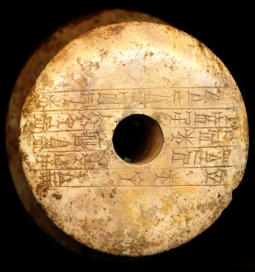Introduction to the Corpus of Sumerian Kassite Texts

Door knob with Sumerian inscription by king Burnaburiaš.BE 1/1,34
The Kassite dynasty, which came to power after the raid on Babylon by the Hittites, reigned over Babylonia for several centuries (ca. 1570 - 1155). Building on developments in the preceding Old Babylonian period, Babylonia developed into a territorial state with remarkable political stability. Kassite kings played an important role in the international politics of the time, maintaining diplomatic contacts with the world powers of the day in the capitals of Egypt, Hatti, Mitanni and Assyria.
Kassites (kaššû) and Kassite names are mentioned in Old Babylonian documents, long before the Kassite dynasty rose to power. The Kassite language was never used in writing and so we know as good as nothing about its structure, vocabulary, or cognates. During the Kassite period Akkadian was used in administration, letters, and divinatory texts; in the late second millennium the language spread all over the Ancient Near East as a lingua franca and diplomatic language. Sumerian, on the other hand, was the language of scholarship and ancient tradition.
Kassite monarchs emphasized in various ways the continuity with ancient Babylonian history. The Sumerian language, which had been a dead language for many centuries, was a powerful way to bring that message in a solemn way with highly scholarly overtones. The Sumerian corpus of the period is not very large, but there are reasons to suspect that we only have a tiny fraction of a rich Sumerian literate culture. There is a substantial number of dedicatory inscriptions commemorating the dedication of a temple, a statue, or an object to a god. Most of these texts follow fairly traditional patterns. The group of Kassite literary texts includes a few new creations (PBS 1/1, 11), but mostly continues Old Babylonian literary tradition, including exemplars of Ninurta's Return (Angim), Inana's Descent, and other compositions. The lexical texts of the period continue Old Babylonian lexical traditions with versions of the thematic list Ura, the list of compound signs Diri or the sign list Ea. These Kassite exemplars fill the gap between the Old Babylonian and first millennium lexical traditions. In addition a few new lexical compositions are attested here for the first time, including the sign list Sb, the so-called group-vocabulary Erimhuš (a very learned series), and the very extensive compilation Nabnītu. Kassite school exercises are known in different formats. They often combine literary and lexical extracts, and occasionally include numerical exercises. The literary extracts are sometimes taken from well-known Sumerian compositions, but there are also examples of school texts with unique Sumerian content (e.g. N 4529). Sumerian seal inscriptions from the Kassite period often have the form of a brief prayer - occasionally in a very artificial style.
27 Dec 2019Further reading
- Bartelmus, Alexa 2010 Restoring the Past. A Historical Analysis of the Royal Temple Building Inscriptions from the Kassite Period. KASKAL 7 (2010) 143-171.
- Limet, Henri 1971 Les légendes des sceaux cassites. Académie royale de Belgique. Classe des lettres. Mémoires 60/2. Brussels: Palais des Académies.
- Van Koppen, Frans 2010 The Old to Middle Babylonian Transition: History and Chronology of the Mesopotamian Dark Age. Ägypten und Levante 20: 453-64.
- Veldhuis, Niek C. 2000 Kassite Exercises: Literary and Lexical Extracts. Journal of Cuneiform Studies 52: 67-94. Download [http://www.jstor.org/stable/1359687] from JSTOR (subscription required).
- Veldhuis, Niek C. 2008 Kurigalzu's Statue Inscription. Journal of Cuneiform Studies 60: 25-51. Download [http://www.jstor.org/stable/25608620] from JSTOR (subscription required).
Niek Veldhuis
Niek Veldhuis, 'Introduction to the Corpus of Sumerian Kassite Texts', Corpus of Kassite Sumerian Texts, The ckst Project, 2019 [http://oracc.org/introduction/]